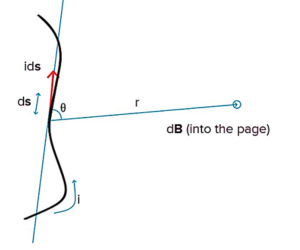Introduction
H.C. Oersted discovered the magnetic effect surrounding the current-carrying conductor in the 19th century. The region around a magnet or current-carrying conductor where another object feels a magnetic force caused by the magnet or current-carrying body is known as the magnetic field. A current-carrying conductor creates a magnetic field all around it homogeneously due to the flow of current-carrying electrons, which generates a magnetic field, and its magnitude is proportional to the current in the conductor. Therefore, the distance from the current-carrying conductor and the total current in the wire control the magnetic force felt by any object near the current-carrying conductor.
What is a Magnetic Field?
An invisible field called a magnetic field surrounds a magnet or a magnetic substance. The magnetic force operates in this field. Other magnetic objects can be drawn into or pushed away from this field by this magnetic force. A magnetic field develops when electrons move in a certain direction having a negative charge. A magnetic field can be represented by drawing magnetic field lines that are continuous lines originating from the north pole of the magnet and migrating towards the south forming continuous loops. Inside a magnet, this orientation is the opposite.
Magnetic Field due to Current Carrying Conductor

We are aware that stationary charges generate an electric field whose strength is proportional to the charge. The same theory may be used in this situation. Moving charges generate a magnetic field proportional to the strength of the current, which causes the conductor carrying the current to generate a magnetic field everywhere around it. Electrons are responsible for producing this magnetic field. Due to its magnitude and direction, the magnetic field can be considered a vector quantity. The magnetic field’s direction is parallel to the wire’s length. It may be provided using the right-hand thumb rule. According to this rule, if we grasp the conductor carrying the current in our right hand and point our thumb in the direction of the current, our curled fingers will point in the direction of the magnetic field lines. This is seen in the diagram below.
Magnetic Field due to a Current-Carrying Wire
Consider a current carrying wire having a current I, then the magnetic field strength B, at a distance r from the wire can be estimated using the formula such that,

The direction of the produced magnetic field due to a current-carrying wire is estimated with the help of the right-hand thumb rule, as shown in the below figure.
Magnetic Force on a Current-Carrying Wire
The equation of the force on a conductor having a charge q and moving through a magnetic field strength of B is given as,
F = qvBsinθ
This equation can also be written as,
F = ![]()
Where L is the length of the wire and t is the time. Rearranging the above equation, we get,

Relation between the Current and Magnetic Field
The relation between current and magnetic field is given by Biot Savart’s Law, such that,

 Summary
Summary
A magnetic field can be created when electrons moving in a certain direction have a negative charge. An invisible field called a magnetic field surrounds a magnet or a magnetic substance. The magnetic force operates in this field. The relationship between the magnetic field and current strength is direct.
Frequently Asked Questions (FAQs)
1. What is the law of Biot Savart?
Ans: By this law, the magnetic field generated due to a small current-carrying element depends upon the square of the distance between the point and the current-carrying element, the magnitude of the current, the length of the current element, and the sine of the angle formed by the current’s direction and the line connecting it. This law is comparable to Coulomb’s law in electrostatics. The vector quantity is represented by this element.
2. What is the Right-Hand Rule of Fleming?
Ans: When our thumb, index finger, and middle finger are arranged so that they are all perpendicular to one another, this law states that the thumb indicates the direction of the conductor’s motion, the middle finger gives the direction of the current induced, and the index finger gives the direction of the magnetic field. Fleming’s Right-Hand Rule determines the direction of the current that develops when a conductor moves through a magnetic field. This principle is utilised in electrical generators.
3. How Current Produces a Magnetic Field?
Ans: Ampere recognized that whenever an electrical charge is moving, a magnetic field is created. Similar to how an electrical current passing through a wire creates a magnetic field, the spinning, and circling of an atom’s nucleus accomplish the same. The magnetic field’s orientation is determined by the spin and orbit directions.
 Mission Statement
Mission Statement
“Empower every student to achieve full potential”
88Guru has been established with the social objective of making quality video-based learning material available to all Indian students. Technology, Connectivity and Social Media are rapidly changing the world of Education and we wish to lead the transformation of the tuition industry in India.
88Guru is the perfect complement to the current tuition model. 88Guru creates a wonderful opportunity for children and parents to bond while engaging in a valuable learning activity. It also provides the complete curriculum at your fingertips for those moments when you need some help at short notice. We believe that this mode of tuition could be transformational, adding hours to a child's day while providing complete control over the learning process.
Every course is taught by the best teachers from India's top schools and conducted in an engaging manner to keep students involved. The e-learning process consists of video-based instructions, computer-graded assignments, and a dashboard which allows the student and parent to track progress.


